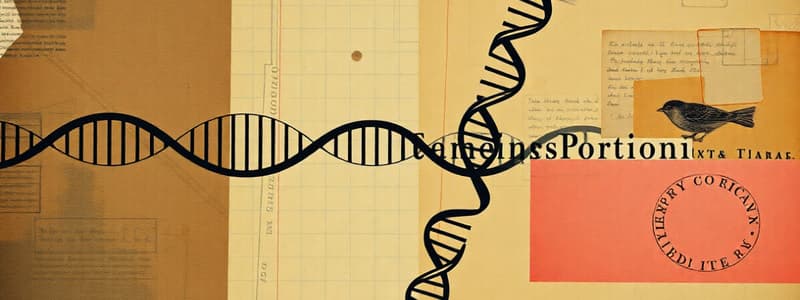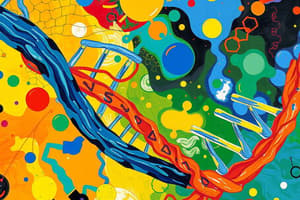Podcast
Questions and Answers
What will occur when a dsDNA fragment with EcoRI sites is treated with the EcoRI enzyme?
What will occur when a dsDNA fragment with EcoRI sites is treated with the EcoRI enzyme?
- It will create 3' overhangs.
- It will create sticky ends with a 5' overhang. (correct)
- It will leave the DNA fragment unchanged.
- It will produce blunt ends.
In the forward orientation of the DNA fragment, which of the following is true regarding the coding and template strands?
In the forward orientation of the DNA fragment, which of the following is true regarding the coding and template strands?
- The template strand is identical to the mRNA sequence.
- The bottom strand is responsible for protein synthesis.
- The coding strand is complementary to the mRNA.
- The top strand is the coding strand and synthesizes the mRNA. (correct)
What would be the result of aligning the sticky ends of the DNA fragment in reverse orientation?
What would be the result of aligning the sticky ends of the DNA fragment in reverse orientation?
- Protein synthesis occurs normally.
- The mRNA will lead to a different set of proteins being synthesized.
- The mRNA produced is identical to the forward orientation.
- No protein can be synthesized from the reverse orientation. (correct)
Which of the following scripts the correct amino acid sequence for the protein initiated from the given mRNA in the forward orientation?
Which of the following scripts the correct amino acid sequence for the protein initiated from the given mRNA in the forward orientation?
What might be the consequence of having an incorrect orientation when ligating the dsDNA fragment into a cloning vector?
What might be the consequence of having an incorrect orientation when ligating the dsDNA fragment into a cloning vector?
Flashcards
Forward Orientation (DNA)
Forward Orientation (DNA)
A DNA fragment inserted into a vector such that transcription and translation occur in the same direction as in the original gene.
Reverse Orientation (DNA)
Reverse Orientation (DNA)
A DNA fragment inserted into a vector, causing transcription and translation to occur in the opposite direction of the original gene, leading to incorrect protein synthesis.
Coding Strand (DNA)
Coding Strand (DNA)
The DNA strand that has the same sequence as the mRNA, except T is replaced by U.
Template Strand (DNA)
Template Strand (DNA)
Signup and view all the flashcards
EcoRI Restriction Enzyme
EcoRI Restriction Enzyme
Signup and view all the flashcards
Study Notes
Double Stranded DNA Orientation
- Double-stranded DNA (dsDNA) fragments have a 'forward' and 'reverse' orientation.
- The coding region of the DNA fragment, is flanked by restriction sites.
- Restriction enzyme EcoRI creates a 5' overhang.
- A cloning vector cut with the same enzyme can create a matching, complementary overhang to allow for a ligation.
- The orientation of the DNA fragment dictates whether a protein can be synthesized.
Forward Orientation
- In forward orientation, the sticky ends of the DNA fragment align correctly to synthesize a protein.
- mRNA is produced based on this orientation.
- Example mRNA sequence and corresponding protein are given.
Reverse Orientation
- In reverse orientation, the sticky ends of the DNA fragment do not align correctly for protein synthesis.
- mRNA is not properly formed for protein production .
- Example is provided of a mRNA sequence that produces no protein in the reverse direction
- Assuming the promoter is to the left of the restriction site, the top strand is the coding strand, and the bottom strand is the template strand.
Studying That Suits You
Use AI to generate personalized quizzes and flashcards to suit your learning preferences.




